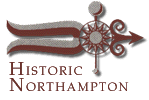
Bridge Street Cemetery Northampton Architecture Historic Markers 
|


About 17th Century Gravestones
In the Connecticut valley less than 100 gravemarkers from before 1700 survive. This is because very few people, generally only well to do white men, could be buried in marked stone graves. Women, children and the poor would be marked with wood crosses (that deteriorated over time), or in unmarked plots. The poor would often be placed on the outer periphery of the cemetery, while the gravestones of the rich occupied the central portion on the cemetery. The oldest surviving stone in the Bridge Street Cemetery is that of Captain E. Gray or Elisha Graves from either 1683 or 85, and though largely unreadable is a good example of a simple headstones, showing only the deceased's name, age, and date of death cut into them. The lack of decoration on 17th century graves was not a result of a lack of material or a lack of trained cutters, rather the Puritan objections to imagery. Stonecutters were local artisans, who did cutting as a side job, but were formally trained under a master cutter. Sandstone, the material of choice in the Bridge Street Cemetery, was cheap and in great abundance, and local-it was quarried at Mount Tom. Although in the early days of the cemetery graves remained undecorated, the exception to the rule of simple undecorated headstones are the tablestone gravemarkers. These mark the clergy and civil leaders, and some had coats of arms cut into them, a symbol of social rank -something the Puritans did not object to.
Contents Historic Northampton.